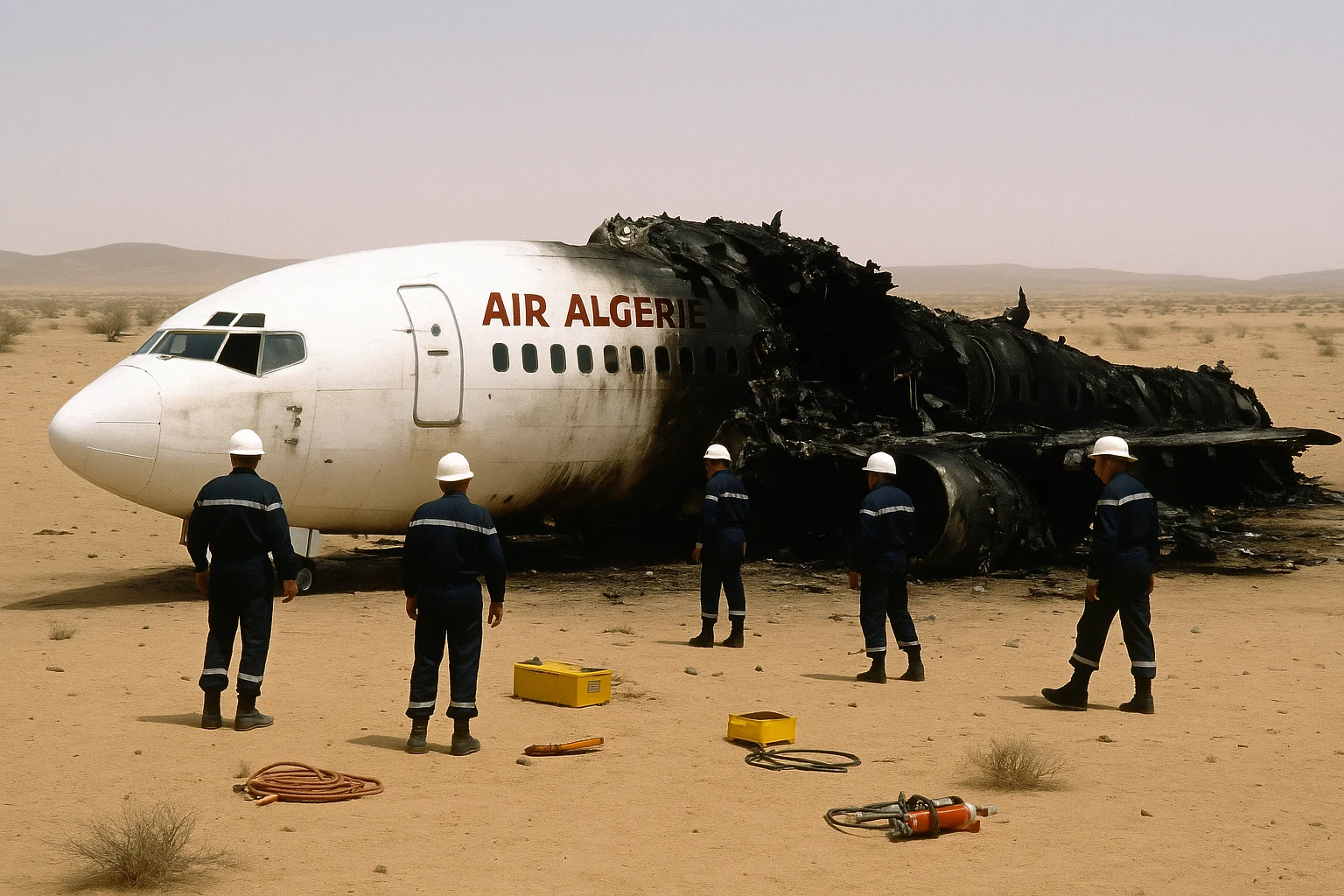
Air Algérie Flight 6289 Crash
by: The Calamity Calendar Team
March 6, 2003
A Routine Flight Shattered
March 6, 2003, promised to be another routine day for Air Algérie Flight 6289. The bustling Tamanrasset Airport, nestled in southern Algeria, buzzed with the usual energy of passengers awaiting journeys to distant destinations. That Thursday afternoon, the Boeing 737-200, one of the older aircraft in the fleet, was scheduled to carry 103 souls—a blend of locals and tourists—on a domestic flight to Algiers, the capital. It was a route routinely traveled, a connective thread across Algeria’s diverse and expansive landscape.
The weather was crisp and calm, ideal conditions for the flight across a vast terrain that harbors both the monumental Saharan dunes and rugged mountains. For most, it felt like just another flight, but as the aircraft taxied down the runway, a nightmare loomed on the horizon, unseen yet waiting to unravel with horrifying speed.
The Sudden Descent into Chaos
As the plane lifted off, thrusting upward into the clear desert sky, no one onboard could have anticipated the drama about to unfold. Within moments of departure, disaster struck. An explosion of mechanical failure disrupted the left-hand engine, a crucial lifeline for the climbing aircraft. As pilots and passengers alike felt the tremor shake through the fuselage, concern turned to crisis.
In the cockpit, the crew worked urgently, facing an immediate and complex challenge. The failure of the engine critically impaired the 737’s performance, transforming its ascent into a perilous descent. The aviation altimeter spun downwards rapidly, marking a race against time. Within less than a minute, what had begun as a routine takeoff spiraled out of control.
Despite efforts to regain stability, the aircraft was unable to maintain altitude. The Boeing 737 crashed just shy of a kilometer from the runway, colliding harshly with the earth and bursting into flames. The force of the impact shattered the aircraft, sending a plume of smoke visible for miles.
The Aftermath: Devastation and Miraculous Survival
When the dust settled, the scale of the tragedy emerged. Of the 103 occupants, 102 lives were lost in the inferno. Among passengers and crew, only one person survived—a passenger seated towards the rear, a singular, miraculous escape from a scene otherwise overwhelmed by loss.
Thanks for subscribing!
In the immediate aftermath, chaos turned to urgency. Rescue and emergency teams descended on the crash site, grappling with a landscape that challenged access while the wreckage threatened with the risk of further collapse or explosion. As the bodies were respectfully retrieved and accounted for, the enormity of the event rippled across the nation.
A Nation in Mourning
News of the crash reverberated through Algeria and far beyond. The deceased represented not just a numerical loss but a mosaic of personal stories abruptly ended. National mourning ensued as families and communities struggled with the weight of sudden farewells.
In Algiers, officials moved swiftly. An investigation spearheaded by Algerian and international aviation experts began, aiming to piece together the causes of the catastrophe amid a backdrop of sorrow and disbelief.
Searching for Answers: The Investigation
The ensuing investigation was both intense and methodical, slowly unraveling the sequence of critical errors. Analysis revealed the primary culprit: a mechanical failure in one of the left engine. Yet, what sent tremors through the aviation community was the realization of the human element—an improper response by the flight crew to the engine failure. This illustrated a broader, more troubling concern about the adequacy of emergency procedure training.
The findings imposed a formidable introspection within Air Algérie, prompting a pivotal reassessment of its operational and pilot training protocols. As conclusions reached beyond Algeria, they contributed to aviation safety discourses worldwide.
Legacy and Lessons Learned
In the years since the crash of Flight 6289, its legacy persists in multiple arenas. The tragedy catalyzed the modernization of aircraft fleets within Air Algérie and instigated a cultural shift emphasizing rigorous pilot training and adherence to emergency protocols. Airlines globally absorbed these lessons too, adding layers of precaution to safeguard against similar tragedies.
Today, the crash of Air Algérie Flight 6289 stands as a somber yet instructive chapter in aviation history. It underscores an indelible truth: that human life, in all its fragility, necessitates unyielding vigilance and commitment to safety in the skies. Every flight is a tapestry woven with lives and stories, each departure a pact of trust in the machinery of technology and human readiness—a pact no one ever wishes to see broken again.
Stay in the Loop!
Become a Calamity Insider and get exclusive Calamity Calendar updates delivered straight to your inbox.
Thanks! You're now subscribed.